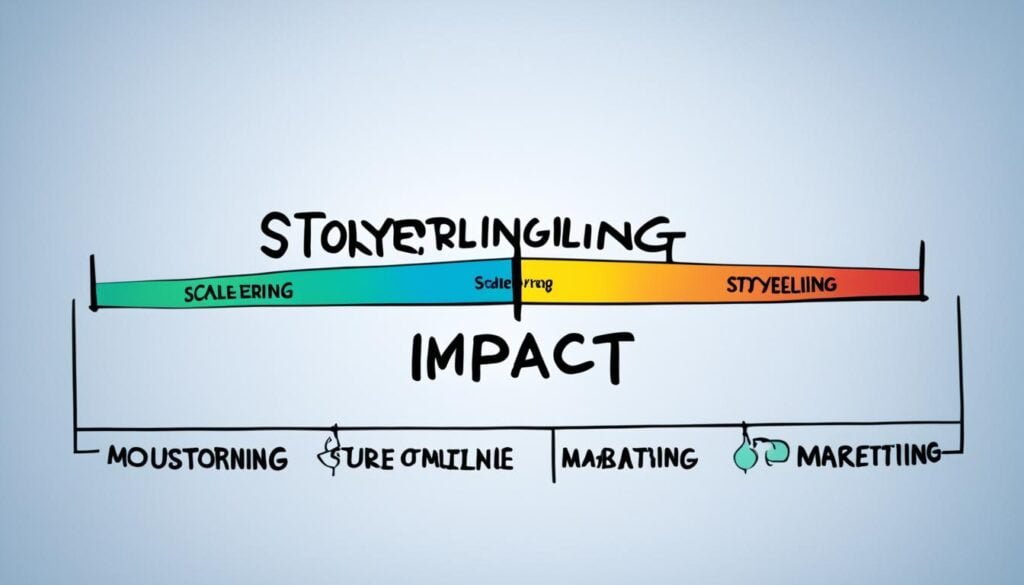Welcome to our article on the power of storytelling in online marketing. In today’s digital age, businesses need innovative strategies to captivate their audience and drive conversions. Storytelling has emerged as a highly effective technique that can connect with customers on an emotional level, leaving a lasting impact. In this article, we will explore how storytelling can be leveraged in various marketing channels to engage customers, build brand loyalty, and ultimately boost your business’s success.
Key Takeaways:
- Storytelling is a powerful tool in online marketing that can engage customers and drive conversions.
- Effective storytelling techniques can help businesses stand out in the crowded online marketplace.
- Storytelling can be used in content marketing, social media marketing, and brand marketing to create impactful narratives.
- Understanding the psychology behind storytelling can enhance your storytelling efforts and resonate with your target audience.
- Consistency and measuring the impact of storytelling are key to success in online marketing.
The Power of Storytelling in Marketing
Storytelling in marketing is a powerful tool that enables businesses to connect with their audience on a deeper level. By crafting compelling narratives, marketers can create emotional connections, make complex ideas accessible, and differentiate their brand.
Creating emotional connections is one of the primary benefits of storytelling in marketing. When businesses evoke feelings and resonate with personal experiences, they tap into the audience’s emotions, fostering empathy and increasing engagement. By triggering emotional responses, storytelling establishes a genuine connection between the audience and the brand, making it more likely for individuals to feel connected to the brand and its offerings.
Moreover, storytelling has the ability to simplify complex ideas and make them more relatable. Often, businesses have intricate products or services that may be challenging for the audience to comprehend. Through storytelling, these complex concepts can be broken down into relatable narratives that the audience can easily understand. This accessibility not only educates the audience but also persuades them to recognize the value of the offerings, thereby increasing the likelihood of conversion.
Furthermore, storytelling enables businesses to differentiate their brand. In a crowded marketplace, it is essential for brands to stand out and capture the attention of their target audience. By showcasing the unique values, mission, and personality of the brand, storytelling creates a distinct identity that sets the brand apart from competitors. Differentiation through storytelling attracts like-minded customers who resonate with the brand’s narrative, values, and offerings, increasing brand loyalty and driving customer preference.
In conclusion, storytelling in marketing is a powerful tool that enables businesses to create emotional connections, make complex ideas accessible, and differentiate their brand. By leveraging the power of storytelling, marketers can captivate their audience, increase engagement, and ultimately drive conversions.
The Elements of Effective Storytelling in Marketing
To create effective storytelling in marketing, we need to understand our audience and tailor our stories to resonate with their values and emotions. By doing so, we can forge a strong connection and captivate their attention. Here are some key elements to consider:
1. Know your audience
Understanding your audience’s demographics, interests, and pain points is crucial for crafting compelling stories that resonate with them. Conduct market research and gather data to gain insights into their needs and preferences. This knowledge will help you create narratives that deeply resonate with your target audience.
2. Define your brand’s narrative
Before embarking on your storytelling journey, define your brand’s narrative by reflecting its values, mission, and personality. Make sure your stories authentically represent your brand across all marketing channels. Consistency is key to building trust and loyalty among your audience.
3. Start with a strong hook
Create a captivating opening that grabs your audience’s attention from the start. A strong hook can be a suspenseful question, a provocative statement, or an intriguing anecdote. It should entice your audience to continue reading or watching, curious to learn more.
4. Create compelling characters
Add depth to your stories by developing compelling characters. Give them distinct personalities, motivations, and challenges that your audience can relate to. Characters humanize your brand, making it more relatable and fostering a connection with your audience.
5. Build tension and conflict
Engaging stories often have a sense of tension and conflict. Introduce challenges or obstacles that your characters must overcome, showcasing how your brand provides solutions to their pain points. This builds anticipation and keeps your audience engaged, eager to learn how the story unfolds.
6. Show transformation
Demonstrate how your product or service can positively impact the lives of your customers. Show the transformation or growth that occurs as a result of engaging with your brand. This not only creates a sense of aspiration but also reinforces the value your brand brings to your audience.
7. Keep it simple and clear
Avoid overcomplicating your storytelling. Use simple, clear language that is easily understandable by your audience. Steer clear of unnecessary jargon or convoluted plots that might confuse or alienate your audience. Focus on delivering your message in a straightforward and relatable way.
8. Use visuals and multimedia
Incorporate visuals and multimedia elements to enhance your storytelling efforts. Images, videos, and interactive content can create a multi-sensory experience that reinforces your narrative and increases engagement. Visuals have the power to evoke emotions and make your stories more memorable.
By implementing these elements, you can create impactful narratives that resonate with your audience, differentiate your brand, and drive conversions.
The Psychology of Storytelling in Marketing
Understanding the psychology behind storytelling is essential for marketers to create narratives that deeply resonate with their audience. By tapping into the power of empathy, utilizing the Zeigarnik effect, harnessing mirror neurons, and incorporating the peak-end rule, marketers can craft stories that leave a lasting impact on their target audience.
Activating Empathy for Increased Trust and Loyalty
Storytelling has the remarkable ability to activate empathy in the audience. When people engage with a compelling story that evokes emotions and reflects their own experiences, it creates a sense of connection and understanding. This emotional bond fosters trust and loyalty towards the brand, strengthening the relationship between the audience and the storyteller.
Utilizing the Zeigarnik Effect to Generate Curiosity and Engagement
The Zeigarnik effect suggests that people remember uncompleted or interrupted tasks better than completed ones. Marketers can apply this psychological principle to storytelling by creating narratives that generate curiosity and leave open loops. By introducing intriguing plot points and unresolved conflicts, marketers pique the audience’s interest and encourage further engagement with the story.
Cultivating Shared Emotional Experiences with Mirror Neurons
Mirror neurons are specialized brain cells that fire when we observe someone else perform an action or experience an emotion. These neurons create shared emotional experiences between the audience and the characters in the story. By crafting relatable characters and evoking authentic emotions, marketers can create a sense of shared connection and understanding, enhancing the impact of their storytelling efforts.
Creating Memorable High Points with the Peak-End Rule
The peak-end rule states that people remember the peak emotional moments and the end of an experience more vividly than the overall experience itself. In storytelling, this highlights the importance of creating memorable high points that leave a lasting impression on the audience. By strategically incorporating emotionally powerful moments and ensuring a satisfying conclusion, marketers can make their stories resonate deeply with their audience, leaving a lasting impact.
| Psychological Principle | Explanation |
|---|---|
| Empathy | The power of storytelling to activate empathy, fostering trust and loyalty. |
| Zeigarnik Effect | Creating narratives that generate curiosity and leave open loops, encouraging further engagement. |
| Mirror Neurons | How mirror neurons create shared emotional experiences between the audience and the characters in the story. |
| Peak-End Rule | The significance of creating memorable high points in storytelling. |
Crafting a Compelling Story: The Harmon Circle Framework
To enhance our storytelling capabilities, we can follow the Harmon Circle framework. This framework provides a step-by-step guide to crafting engaging narratives that captivate our audience and leave a lasting impact. By applying the Harmon Circle framework to brand storytelling, we can create compelling stories that take our audience on a captivating journey.
The Harmon Circle framework consists of the following key elements:
- Introduce the protagonist and their world: Start by introducing the main character of our story and setting the stage for their journey. This helps to establish a connection between the audience and the protagonist.
- Define the protagonist’s goal or desire: Clearly define what the protagonist wants to achieve or obtain. This goal or desire will serve as the driving force behind the story.
- The protagonist embarks on a journey: Take the audience on a journey with the protagonist as they strive to achieve their goal or desire. This journey should be filled with challenges, setbacks, and moments of growth.
- Encounter challenges and obstacles: Introduce various challenges and obstacles that the protagonist must overcome. These challenges create tension and keep the audience engaged in the story.
- Find what they are looking for: As the story progresses, the protagonist should make progress towards their goal or desire. This could involve discovering new information, gaining insights, or finding valuable resources.
- Return to where they began: Bring the story full circle by bringing the protagonist back to the starting point. This could be a physical return or a metaphorical return to a key theme or idea.
- Undergo a transformation: Show how the protagonist has grown and changed as a result of their journey. This transformation should be meaningful and resonate with the audience.
By following the Harmon Circle framework, we can craft brand stories that capture the imagination of our audience and leave a lasting impression. This framework provides a structured approach to storytelling, ensuring that our narratives are engaging, compelling, and impactful. So let’s use the Harmon Circle framework to create stories that resonate with our audience and bring our brand to life.

Storytelling Across Different Marketing Channels
Storytelling plays a vital role in connecting with your audience and enhancing brand communication across various marketing channels. By incorporating brand storytelling into your marketing strategies, you can create narratives that captivate and engage your target audience.
Brand storytelling: Brand storytelling allows companies to showcase their values, history, and mission through compelling narratives. By sharing stories that resonate with your audience, you can establish a strong emotional connection and build brand loyalty.
Content marketing: Content marketing provides an ideal platform for storytelling. Through blogs, articles, and videos, you can craft stories that speak directly to your target audience. By addressing their pain points, sharing success stories, or providing valuable insights, you can create content that resonates and drives engagement.
Social media marketing: Social media platforms offer a diverse range of storytelling opportunities. With visually-rich content, micro-stories, user-generated content, and interactive elements, you can leverage social media to create immersive storytelling experiences. By incorporating storytelling into your social media strategy, you can capture attention, foster engagement, and drive brand awareness.
Influencer marketing: Influencer marketing provides a unique opportunity to integrate storytelling into sponsored content. Influencers, with their personal experiences and authentic voices, can share stories that resonate with their followers. By partnering with influencers who align with your brand values, you can amplify your storytelling efforts and reach a wider audience.
By embracing storytelling across different marketing channels, you can leverage the power of narrative to enhance brand communication, engage your audience, and drive meaningful connections.

The Importance of Emotional Storytelling
Storytelling in marketing holds immense power, and a key aspect of its effectiveness lies in its ability to evoke emotions. By tapping into universal emotions such as joy, fear, or nostalgia, storytelling becomes a persuasive tool that can significantly influence consumer behavior. When stories resonate with individuals on an emotional level, they are more likely to form deep connections with the brand and engage further with its offerings.
Relatability is another crucial factor in storytelling. When people can relate to the characters or scenarios presented in a story, they feel a stronger connection and are more inclined to invest their attention and trust in the brand. By weaving relatable elements into the narrative, businesses can create a sense of authenticity and empathy, which fosters a deeper connection between the audience and the brand.
However, it is crucial to ensure that the storytelling remains relevant to the audience. Irrelevant storytelling can have a negative impact on the brand’s image, as it fails to resonate with the audience or address their needs and desires. To create impactful storytelling, businesses must understand their target audience and tailor their narratives accordingly, making sure the stories align with the values and aspirations of the customers.
The power of emotional storytelling lies in its ability to tap into the core of human experiences, thereby forging a bond between the audience and the brand. When emotions are evoked, and relatability is achieved, storytelling has the potential to drive significant impact on brand perception and consumer behavior.
In conclusion, emotional storytelling in marketing is a compelling tool that can captivate the audience and influence their perceptions and actions. By evoking emotions and ensuring relatability, businesses can create a meaningful connection with their target audience, ultimately boosting engagement and driving conversions.

Consistency and Measurement
Consistency across channels and measuring storytelling impact are crucial aspects of effective marketing. Maintaining a cohesive brand narrative across all marketing channels helps reinforce the brand identity and ensures a unified brand experience for the audience. By integrating the brand story seamlessly into websites, social media platforms, email campaigns, and other touchpoints, we create a consistent and compelling message that resonates with the target audience.
Measuring the impact of storytelling efforts is equally important to track engagement metrics, brand sentiment, and conversion rates. By monitoring these metrics, we can gain valuable insights into the effectiveness of our storytelling campaigns and make data-driven decisions for future storytelling strategies. Understanding the impact of storytelling not only helps in evaluating the success of our efforts but also provides valuable feedback for continual improvement.
Incorporating storytelling into marketing is an ongoing process, and consistent monitoring and measurement allow us to refine our techniques and optimize our storytelling strategies for better results.

Conclusion
Storytelling is an invaluable tool for businesses in the world of marketing. It allows us to captivate our audience, differentiate our brand, and drive meaningful conversions. By crafting compelling narratives that create emotional connections, simplify complex ideas, and reflect our brand’s values, we can cut through the noise and leave a lasting impact on our audience.
Understanding the psychology behind storytelling and employing effective techniques enables us to create narratives that deeply resonate with our target audience. By harnessing the power of storytelling, we can transform our brand communication, foster brand loyalty, and ultimately achieve success in a competitive market.
As marketers, it is essential to remember that storytelling is not just a trend, but rather a timeless strategy that continues to be relevant in the ever-evolving landscape of marketing. By applying storytelling techniques and staying up-to-date with the latest trends, we can effectively engage our audience, differentiate our brand, and drive conversions. So, let us embrace the power of storytelling and unlock endless possibilities for our marketing endeavors.
FAQ
What is the power of storytelling in marketing?
Storytelling in marketing allows businesses to create emotional connections with their audience, making it a potent tool for engagement, brand loyalty, and driving conversions.
How does storytelling differentiate a brand?
Storytelling can differentiate a brand by showcasing its unique values, mission, and personality, attracting like-minded customers and giving them a reason to choose your products or services.
What are the elements of effective storytelling in marketing?
The elements of effective storytelling in marketing include knowing your audience, defining your brand’s narrative, starting with a strong hook, creating compelling characters, building tension and conflict, showing transformation, keeping it simple and clear, and using visuals and multimedia.
What is the psychology behind storytelling in marketing?
The psychology behind storytelling in marketing involves activating empathy in the audience, leveraging the Zeigarnik effect to generate curiosity, using mirror neurons to create shared emotional experiences, and applying the peak-end rule to create memorable high points.
How can I craft a compelling story in marketing?
You can use the Harmon Circle framework, which includes introducing the protagonist and their world, defining the protagonist’s goal, the protagonist embarking on a journey, encountering challenges and obstacles, finding what they are looking for, returning to where they began, and undergoing a transformation.
How can storytelling be incorporated into different marketing channels?
Storytelling can be incorporated into different marketing channels such as brand storytelling, content marketing, social media marketing, and influencer marketing.
What is the importance of emotional storytelling in marketing?
Emotional storytelling is important in marketing as it taps into universal emotions, creates relatability, and influences consumer behavior.
How important is consistency in storytelling and how can it be measured?
Consistency in storytelling is essential to reinforce the brand narrative and create a cohesive brand identity. The impact of storytelling efforts can be measured by tracking engagement metrics, brand sentiment, and conversion rates.
What is the significance of storytelling in online marketing?
Storytelling in online marketing is a powerful tool that enables businesses to engage their audience, stand out in a crowded marketplace, and drive conversions.

